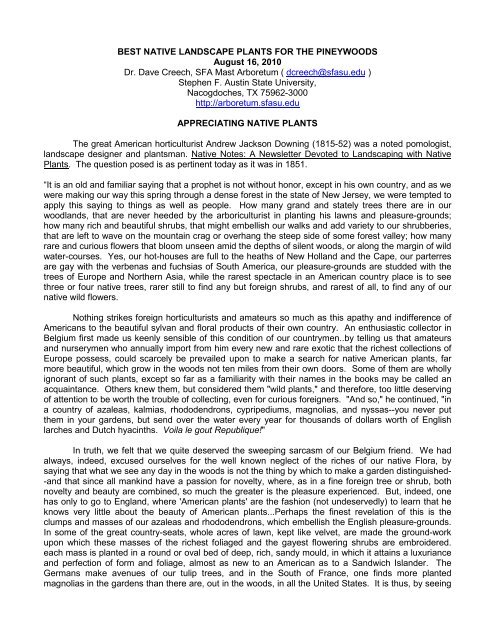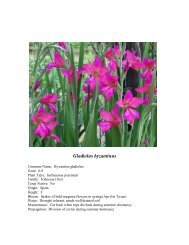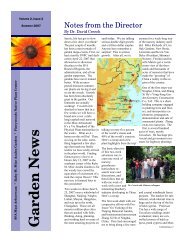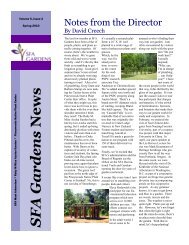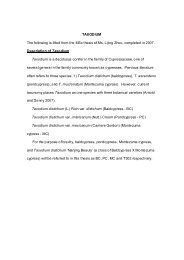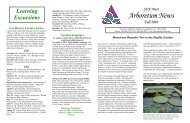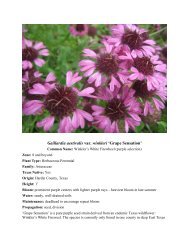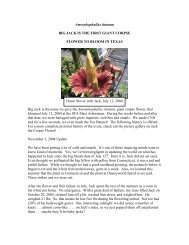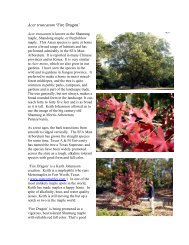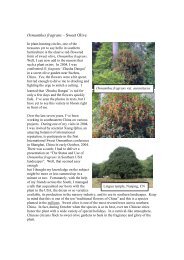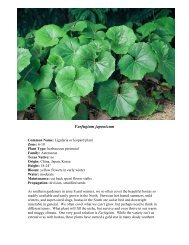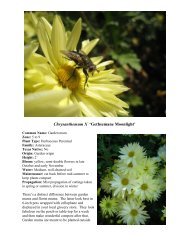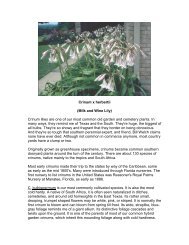native plants primer - SFA Gardens - Stephen F. Austin State ...
native plants primer - SFA Gardens - Stephen F. Austin State ...
native plants primer - SFA Gardens - Stephen F. Austin State ...
You also want an ePaper? Increase the reach of your titles
YUMPU automatically turns print PDFs into web optimized ePapers that Google loves.
BEST NATIVE LANDSCAPE PLANTS FOR THE PINEYWOODS<br />
August 16, 2010<br />
Dr. Dave Creech, <strong>SFA</strong> Mast Arboretum ( dcreech@sfasu.edu )<br />
<strong>Stephen</strong> F. <strong>Austin</strong> <strong>State</strong> University,<br />
Nacogdoches, TX 75962-3000<br />
http://arboretum.sfasu.edu<br />
APPRECIATING NATIVE PLANTS<br />
The great American horticulturist Andrew Jackson Downing (1815-52) was a noted pomologist,<br />
landscape designer and <strong>plants</strong>man. Native Notes: A Newsletter Devoted to Landscaping with Native<br />
Plants. The question posed is as pertinent today as it was in 1851.<br />
“It is an old and familiar saying that a prophet is not without honor, except in his own country, and as we<br />
were making our way this spring through a dense forest in the state of New Jersey, we were tempted to<br />
apply this saying to things as well as people. How many grand and stately trees there are in our<br />
woodlands, that are never heeded by the arboriculturist in planting his lawns and pleasure-grounds;<br />
how many rich and beautiful shrubs, that might embellish our walks and add variety to our shrubberies,<br />
that are left to wave on the mountain crag or overhang the steep side of some forest valley; how many<br />
rare and curious flowers that bloom unseen amid the depths of silent woods, or along the margin of wild<br />
water-courses. Yes, our hot-houses are full to the heaths of New Holland and the Cape, our parterres<br />
are gay with the verbenas and fuchsias of South America, our pleasure-grounds are studded with the<br />
trees of Europe and Northern Asia, while the rarest spectacle in an American country place is to see<br />
three or four <strong>native</strong> trees, rarer still to find any but foreign shrubs, and rarest of all, to find any of our<br />
<strong>native</strong> wild flowers.<br />
Nothing strikes foreign horticulturists and amateurs so much as this apathy and indifference of<br />
Americans to the beautiful sylvan and floral products of their own country. An enthusiastic collector in<br />
Belgium first made us keenly sensible of this condition of our countrymen..by telling us that amateurs<br />
and nurserymen who annually import from him every new and rare exotic that the richest collections of<br />
Europe possess, could scarcely be prevailed upon to make a search for <strong>native</strong> American <strong>plants</strong>, far<br />
more beautiful, which grow in the woods not ten miles from their own doors. Some of them are wholly<br />
ignorant of such <strong>plants</strong>, except so far as a familiarity with their names in the books may be called an<br />
acquaintance. Others knew them, but considered them "wild <strong>plants</strong>," and therefore, too little deserving<br />
of attention to be worth the trouble of collecting, even for curious foreigners. "And so," he continued, "in<br />
a country of azaleas, kalmias, rhododendrons, cypripediums, magnolias, and nyssas--you never put<br />
them in your gardens, but send over the water every year for thousands of dollars worth of English<br />
larches and Dutch hyacinths. Voila le gout Republique!"<br />
In truth, we felt that we quite deserved the sweeping sarcasm of our Belgium friend. We had<br />
always, indeed, excused ourselves for the well known neglect of the riches of our <strong>native</strong> Flora, by<br />
saying that what we see any day in the woods is not the thing by which to make a garden distinguished-<br />
-and that since all mankind have a passion for novelty, where, as in a fine foreign tree or shrub, both<br />
novelty and beauty are combined, so much the greater is the pleasure experienced. But, indeed, one<br />
has only to go to England, where 'American <strong>plants</strong>' are the fashion (not undeservedly) to learn that he<br />
knows very little about the beauty of American <strong>plants</strong>...Perhaps the finest revelation of this is the<br />
clumps and masses of our azaleas and rhododendrons, which embellish the English pleasure-grounds.<br />
In some of the great country-seats, whole acres of lawn, kept like velvet, are made the ground-work<br />
upon which these masses of the richest foliaged and the gayest flowering shrubs are embroidered.<br />
each mass is planted in a round or oval bed of deep, rich, sandy mould, in which it attains a luxuriance<br />
and perfection of form and foliage, almost as new to an American as to a Sandwich Islander. The<br />
Germans make avenues of our tulip trees, and in the South of France, one finds more planted<br />
magnolias in the gardens than there are, out in the woods, in all the United <strong>State</strong>s. It is thus, by seeing
them away from home, where their merits are better appreciated, and more highly developed, that one<br />
learns for the first time what our gardens have lost by having none of the "American <strong>plants</strong>" in them. “<br />
Isn’t it interesting that most of the trees used in East Texas landscapes are <strong>native</strong>s and most<br />
shrubs are not? Traditions in our plant heritage appear most to blame behind this dichotomy, a<br />
landscape evolution that has led to our present urban landscape philosophy. After all, most early<br />
settlers were too busy worrying about survival to be concerned with landscaping their property. The<br />
interest was with food CROPS - grains, vegetables and fruit dominated their motivation. After security<br />
and a little prosperity settled in, Americans (immigrants with a recent memory of the Old World) were<br />
eager to surround themselves with familiar <strong>plants</strong> from their homeland. Showy, flowering <strong>plants</strong> were<br />
preferred for the home site and old standards made their mark. Quinces, Forsythias, and Spiraeas dot<br />
the south because they are very durable, tend to survive with humans around or not. Native <strong>plants</strong><br />
often failed to make inroads. It was easy for early settlers to move small shrubs, cuttings, and seeds<br />
from one location to another. With <strong>plants</strong> came design. Each ethnic group carved out a philosophy of<br />
display and utility; the swept floor, yard fence, farm garden/orchard and an assortment of perennials<br />
characterized many southern homescapes. Old <strong>plants</strong> - many that lost favor as trends and fashion<br />
concepts changed - are now enjoying a resurgence of interest in a garden public starving for plant<br />
information and for <strong>plants</strong> that last.<br />
In the vernacular of the times, the <strong>native</strong> “xeriscape” garden is one designed to include species<br />
that will survive and thrive without irrigation. In our area of Texas, we can successfully cultivate many<br />
of the dry lovers from this portion of the state and parts west. Besides creating an attractive and less<br />
demanding landscape, a properly maintained xeriscape can conserve a considerable amount of water.<br />
Think about it: each year, Fort Worth area residents pour more than 11 billion gallons of water on their<br />
lawns and gardens, enough water to fill Lake Worth. The cost of providing a safe and plentiful water<br />
supply continues to rise. The average Fort Worth resident's water bill more than doubles during the<br />
summer months of June to September. As much as 50 percent of this additional water is used to<br />
irrigate lawns and gardens. Landscape experts agree that a lawn can be maintained in an attractive<br />
and healthy appearance with up to 50 percent less water than is typically used. Practicing xeriscape<br />
principles results in sustainable landscapes, and at the same time creates attractive and unique<br />
gardens that result in the highest water savings.<br />
The degree of interaction by humans and the “natural” landscape can create differences of<br />
opinion. Surely, we all recognize that <strong>native</strong> plant communities are useful in many types of landscapes,<br />
including urban sites, and are best used to reflect a connection with the <strong>native</strong> natural world. While<br />
only slightly contrived, landscapes that are dominated by the smart use of <strong>native</strong> <strong>plants</strong> are the best<br />
landscapes. In the Mast Arboretum and Ruby M. Mize Azalea Garden which is a mixed (<strong>native</strong> and<br />
non-<strong>native</strong>) landscape, we attempt to extend beyond nature's exemplary combining of plant species. "In<br />
selecting plant combinations, we set out to achieve in a mortal life span what has taken nature<br />
thousands of years to accomplish" (Flint, 1987). What we are attempting to do at the Pineywoods<br />
Native Plant Center and <strong>SFA</strong> Recreational Trails and Garden is skip a succession generation and lay<br />
out a smart selection of <strong>native</strong> trees and shrubs – with diversity, mapping, and documentation the rule.<br />
To position <strong>plants</strong> correctly one should first consider their needs (soils, light, moisture, shade, and how<br />
well they deal with competitive forest root systems. While landscapers can enjoy great latitude in<br />
integrating a diverse palette of plant materials into a garden design theme, some combinations make<br />
little sense – choosing <strong>plants</strong> on light, moisture and soil preferences still allows a limitless list to choose<br />
from. The following woody <strong>native</strong>s are suggested for East Texas and recommendations are based on<br />
observations at the <strong>SFA</strong> Mast Arboretum and Pineywoods Native Plant Center.
ACERACEAE<br />
Acer rubrum Red Maple<br />
THE BEST NATIVE TREES AND SHRUBS FOR EAST TEXAS<br />
Height: to 40' - Leaves: simple, opposite, 3 to 5 lobed, deciduous<br />
Flowers: dioecious, bright red flowers in very early spring.<br />
Color selections are available known for fall foliage brilliance. Full sun, well-drained soils, good<br />
moisture in establishment years, brittle, relatively short-lived. 'Autumn Flame' and 'October<br />
Glory' are good cultivars. We are promoting ‘King’s Highway’, a selection by Sherwood Aikens<br />
of Sibley, Louisiana, found in Shreveport with brilliant red foliage. Acer rubrum var. drummondii,<br />
the Drummond red maple or swamp red maple, tolerates wetter sites.<br />
Acer saccharum Sugar maple<br />
Height: 60'<br />
Leaves: simple, opposite, to six inches across, 3 to 5 lobed.<br />
Flowers: inconspicuous<br />
There's some confusion between this species and Acer barbatum, the Florida maple common in<br />
the woods of east Texas. Has performed well in full sun if mulched and watered first few years.<br />
Good fall color, light bark, good shade tree. Not for poor, harsh landscapes. Like many maples,<br />
sensitive to bark injury via weedeaters and lawnmowers.<br />
AQUIFOLIACEAE<br />
Ilex ambigua Carolina holly<br />
Height: 6 - 12 feet<br />
Leaves: dark green (deciduous)<br />
Flower: white, April-June<br />
Use as per deciduous holly, full sun, inconspicuous flowers in April/May; red berries in October<br />
and November, full sun to a little shade; very sandy, well-drained acid soils; We have had poor<br />
luck establishing the plant at the arboretum, probably because we have done a poor job of site<br />
preparation (improving drainage). The plant is beautiful and somewhat rare and is often at<br />
home as a forest edge specimen on very sandy soil.<br />
Ilex decidua Deciduous holly<br />
Height: 7 - 15 feet<br />
Leaves: dark green, lustrous changing to yellow in the fall (deciduous)<br />
Fruit: orange to scarlet, September
One of our favorites; gaining in popularity; multi-stem specimen, red and orange berried<br />
cultivars available. 'Warren's Red', 'Council Fire', and 'Pocohantas' are good selections. The<br />
PNPC and <strong>SFA</strong> Mast Arboretum are home to over a dozen cultivars. A mature multi-stem<br />
deciduous holly can be quite stunning. Variety evaluations in side by side comparisons are<br />
needed. Prefers full sun to almost full sun – some genotypes sucker more than others –<br />
suckers easily moved to another location to start a new plant. See a good plant? Check for<br />
suckers – and bring us one!<br />
Ilex glabra Inkberry<br />
Height: 6 - 8 feet<br />
Leaves: lustrous dark green sometimes yellow green (evergreen)<br />
Fruit: black berry, September-May<br />
Wetland <strong>native</strong> excellent for foundation, hedges, masses, or as an accent plant. Slow-growing.<br />
Deserves more investigation. Hot plant in the trade. ‘Shamrock’, ‘white-fruited’ and many other<br />
varieties under test in the Arboretum.<br />
Ilex opaca American holly<br />
Height: to 30' although dwarf forms available.<br />
Leaves: lustrous green, spiny.<br />
Fruit: red berries in late fall on fruiting selections.<br />
The <strong>SFA</strong> Mast Arboretum’s original signature plant, long ago lost in history. Certainly<br />
underutilized and not as popular as the hybrids with nurserymen, simply because they grow<br />
faster, sell faster. American Holly grows a bit slow. Lots of attributes: evergreen, dense foliage,<br />
bright red berries in fall and winter (yellow berried forms available), striking bark interest, few<br />
pests, and extremely durable once established. Full sun, moderately well-drained soils best.<br />
Responds to irrigation and enhanced soil nutrition; shallow root system benefits by a mulching<br />
program. Considered to be slow growing in the landscape. Sensitive to weed eaters when<br />
young. <strong>SFA</strong>SU Arboretum has over 30 cultivars under evaluation and many look strong. Quite a<br />
variation in growth rates. ‘Maryland dwarf’ and ‘Clemson Spreading’ are interesting dwarf<br />
forms. Yellow berried forms as well.<br />
Ilex verticillata Coralberry<br />
Height: 6 - 10 feet<br />
Leaves: deep rich green (deciduous)<br />
Fruit: bright red, August-September<br />
Grows well in wet, poorly-drained soils and deserves more use in such sites. Deciduous; good<br />
fall color; acid soil but reported to tolerate higher pH. We have eight cultivars in the arboretum<br />
that look good. I’m still trying to locate 'Chrysocarpa', 'Fastigata', 'Padifolia', and 'Naria.’
Ilex vomitoria Yaupon<br />
Height: 2'(dwarfs) to 20+ feet.<br />
Leaves: small, evergreen.<br />
Fruit: red, yellow, October - November<br />
Good selection of cultivars, very durable landscape plant. Weeping, fastigate, and dwarf forms<br />
available. Full sun preferred. 'Jewel', 'Otis Miley' (yellow fruit), 'Yawkeyii' (yellow fruit), 'Folsom's<br />
Weeping', 'Fleming Upright', and many others perform well. While relatively free of insects and<br />
diseases, a leaf psyllid has been a problem in Nacogdoches landscapes, causing new growth<br />
and leaves to contort and fail to unfold fully. There's probably some resistance out there.<br />
BIGNONIACEAE<br />
Bignonia capreolata cross vine<br />
Height: depends on structure, will climb 30 - 50 feet<br />
Leaves: dark green turning reddish purple in cold weather<br />
(semi-evergreen)<br />
Flower: orange to red trumpet shaped, April-June and sporadic throughout the year.<br />
An absolutely stunning evergreen vine for east Texas. Needs good positioning to maximize<br />
impact. Young plant grows best in morning till noon shade and the plant flowers best when the<br />
crown can get full sun. Moist soils when young; vine is very drought tolerant when well<br />
established. 'Atrogsanguinea' is an excellent red color selection. We also have ‘Tangerine<br />
Beauty’, ‘Helen Friedel’, ‘Jekyll Island’, and ’Dragon Lady’. Plant needs the head of plant able to<br />
enjoy full sun when mature.<br />
CAPRIFOLIACEAE<br />
Viburnum acerifolium Maple-leaf viburnum<br />
Height: 4 - 6 feet<br />
Leaves: bright green changing to red or purple in fall (deciduous)<br />
Flower: yellowish white, June<br />
A rather rare <strong>native</strong> shrub in east Texas. A shade-tolerant species with brilliant fall colors<br />
(creamy-pink, rose, red, to grape juice purple). Appreciates a well-drained soil with good<br />
moisture for first few years. Somewhat difficult to locate in the trade.<br />
Viburnum dentatum Arrow-wood viburnum<br />
Height: 6 - 15 feet
Leaves: dark green changing to yellow or reddish purple in fall<br />
(deciduous)<br />
Flower: white, cream colored due to yellow stamens, May<br />
Responds to pruning. Tree or bush form. Thicker plant when grown in full sun. Moderately welldrained<br />
soils. Good performer in the Arboretum.<br />
Viburnum rufidulum Rusty blackhaw<br />
Height: 4 - 8 feet as a shrub, 8 - 20 feet as a tree<br />
Leaves: dark green changing to red in fall (deciduous)<br />
Buds are covered with a deep rich rusty brown pubescence, hence the name; excellent plant<br />
and should be used more widely. Bright white flowers in the spring and some genotypes have<br />
have great fall color. Part shade, moist soils..<br />
Viburnum nitidum Witherod<br />
Height: 12'<br />
Leaves: lustrous green<br />
Flower: white in May,<br />
Semi-evergreen, lustrous green leaves, white flowers in May; responds to pruning by becoming<br />
dense. Needs more use.<br />
Viburnum nudum Possumhaw viburnum<br />
Height: 12'<br />
Leaves: Opposite, simple, variable.<br />
Flower: Off-white, dense, 4" across.<br />
Another full sun to part shade species. Moist soils. We have an outstanding plant in the bog in<br />
wet soil that has bright red leaves in the fall.<br />
CELASTRACEAE<br />
Euonymus americanus strawberry bush<br />
Height: 4 - 6 feet<br />
Leaves: dark green changing to yellow green in fall (evergreen)<br />
Flower: 5 petaled greenish purple, July-September
Goes unnoticed until September or October when the warty, scarlet capsules open to display<br />
orange seeds. From this character it gets it's other common name "hearts-a-burstin". Not<br />
susceptible to scale. We have a Dodd narrow-leafed and an "evergreen" selection.<br />
CUPRESSACEAE<br />
Taxodium distichum var. distichum Baldcypress<br />
Height: 100’<br />
Foliage: needles in splay, fall foliage color variable<br />
This deciduous conifer should be planted everywhere. Name a tree that lives thousands of<br />
years, is relatively free of insects and diseases, produces valuable lumber, can live in water, is<br />
tolerant of drought when it’s well established, lets the light in during the winter when you need it.<br />
Puts on a cloak of green in the summer when you need it more. Knees can be a nuisance.<br />
Central Texas Taxodiums are less like to push knees. There are many varieties but they are<br />
hard to find. ‘Cascade Falls’ is a dramatic weeper. <strong>SFA</strong> is home to about as many Taxodium<br />
genotypes as anywhere in the world. Taxodium distichum var. Imbricarium is Pondcypress and<br />
is generally considered <strong>native</strong> to SE Louisiana and states east of that. There is a magnificent<br />
in-the-swamp Pondcypress in SE Texas at Shangrla Botanical <strong>Gardens</strong>.<br />
CYRILLACEAE<br />
Cyrilla racemiflora Swamp Cyrilla - TiTi<br />
Height: 10 - 25 feet<br />
Leaves: dark green above, bright green below changing to orange in fall (persistent)<br />
Flower: striking white 6" inflorescence, June-July<br />
Also known as titi, a beautiful shrub for foliage and spider-like flowers, can be grown from zone<br />
6 south, belongs in a naturalistic wetland setting. Full sun; attractive to bees.<br />
FAGACEAE<br />
Quercus alba White oak<br />
Height: 50 - 80 feet<br />
Leaves: grayish pink when unfolding, then turning dark green changing to red or wine colored in<br />
fall (deciduous). Doubtful for high use due to slow growth, and difficulty in transplanting;<br />
however, this is a majestic and worthwhile tree for large areas. Long-lived.<br />
Quercus incana Bluejack oak<br />
Height: 12 - 30 feet<br />
Leaves: grayish green above, white below (deciduous)<br />
Landscape Value: small, nicely shaped tree for poor sandy sites.
Quercus lyrata Overcup oak<br />
Height: 30 - 50 feet<br />
Leaves: dark green and leathery changing to tannin brown in fall (deciduous)<br />
Fruit: almost entirely covered, hence the name. Good choice for difficult sites (flooding and<br />
slopes).<br />
Quercus shumardii Shumard oak<br />
Height: 50 - 70 feet<br />
Leaves: dark green and lustrous, turning orange in fall (deciduous)<br />
Landscape Value: very desirable due to unique leaf shape, works well as an accent plant,<br />
brilliant fall color.<br />
Quercus stellata Post oak<br />
Height: 40 - 60 feet<br />
Leaves: dark green, cross shaped with rounded edges (deciduous)<br />
Landscape Value: dense round topped crown with stout spreading branches.<br />
Quercus michauxii Swamp chestnut oak<br />
Height: 20 - 60 feet<br />
Leaves: dark green lustrous above, silvery white pubescent below (deciduous)<br />
Grayish flaky bark, heavy mast producer for poorly drained sites. Good fall color.<br />
Castanea pumila Allegheny chinkapin<br />
Height: 12 - 20 feet<br />
Leaves: yellowish green above, white pubescent below (deciduous)<br />
Fruit: nut enclosed in a bur with spike like clusters. Most trees form clumps resulting from<br />
repeated dieback and sprouting (Chestnut blight).<br />
HAMAMELIDACEAE<br />
Hamamelis virginiana Witch-hazel<br />
Height: 20 - 30 feet<br />
Leaves: medium green changing to yellow in fall (deciduous)<br />
Flower: yellow fragrant, October-December.
Works well in a shrub border, near buildings in shaded areas.<br />
HIPPOCASTANACEAE<br />
Aesculus arguta Texas buckeye<br />
Height: 15 - 20 feet<br />
Leaves: rich green lustruous, 7-9 leaflets (deciduous)<br />
Flower: yellow 4-8 inches, March-May; Stunning in early spring as leaves are unfurled.<br />
Aesculus pavia Red buckeye<br />
Height: 10 - 20 feet<br />
Leaves: dark green lustrous, 5 leaflets (deciduous)<br />
Flower: red to white, March-May; Handsome tree in flower, best in full sun.<br />
A must have for the serious <strong>native</strong> garden – great flowers – tough as nails, having learned long<br />
ago to go to sleep fairly early. Loses leaves in the end of summer.<br />
LEGUMINOSAE<br />
Gleditsia triacanthos Honey locust<br />
Height: 30 - 70 feet<br />
Leaves: bright green changing to yellow in fall (deciduous)<br />
Flower: greenish yellow, fragrant; Excellent lawn tree for filtered shade; 'inermis' is without<br />
thorns and much preferred.<br />
MAGNOLIACEAE<br />
Magnolia grandiflora Southern magnolia<br />
Height: 60 - 80 feet<br />
Leaves: lustruous dark green above, pubescent below (persistent)<br />
Fruit: rose red; Flower: creamy white and fragrant, 8-12 inches, May-June<br />
Landscape Value: handsome, worthwhile tree, needs room to develop. ‘Little Gem’ and<br />
‘Bracken’s Brown Beauty’ are semi-dwarfs. Many exciting new cultivars.
Magnolia macrophylla Bigleaf Magnolia<br />
Height: 30-40 feet.<br />
Leaves: 12-32 inches long, 7-12 inches wide, bright green and glabrous above, silvery gray and<br />
downy below, (deciduous)<br />
Flower: creamy white, 8-10 inches across, 6 petals, fragrant, June<br />
A round-headed, cumbersome, deciduous landscape specimen; needs to be positioned out of<br />
the wind; A fine candidate for the edge of a creek in a sheltered location with part sun for four to<br />
six hours per day. Can burn in a drought so should be positioned to receive an emergency<br />
irrigation during the worst dry spells. Giant leaves the main interest but flowers are huge,<br />
fragrant and awe inspiring. Litter problems makes this a better woodland plant than a specimen<br />
for the well-manicured yard. Being hit by a 30"-long leaf is not funny to the average homeowner.<br />
Magnolia pyramidata Pyramid magnolia<br />
Height: 25 to 40 feet<br />
Leaves: 6-8 inches long, bright green above, (deciduous)<br />
Flower: 6-15 petalled, 4 inches in diameter, creamy white<br />
A rare plant in Texas known only from one provenance on the Jasper/Newton county line. A<br />
slender tree with ascending branches; likes moist rich soils; works well along creeks or streams,<br />
adds flavor to the landscape with leaf and bark interest; worthy of introduction into East Texas<br />
landscapes to "rescue" the species.<br />
Magnolia virginiana Sweet bay<br />
Height: 10 - 50 feet<br />
Leaves: dark green above, white below (deciduous)<br />
Flower: creamy white, lemon scented, May-June<br />
Graceful small specimen tree, foliage is handsome in wind as it buffets the leaves exposing the<br />
underside. M. virginiana var. australis is semi-evergreen in the <strong>SFA</strong>SU arboretum. Dodd's<br />
nursery, Semmes Alabama is marketing a little-leaf, little-bloom dwarf sweet bay that appears to<br />
have merit. Ours has been very slow to get started! Prefers moist soil but quite tolerant of dry<br />
soils once well established.<br />
MYRICACEAE<br />
Myrica cerifera southern wax myrtle<br />
Height: 10 - 20 feet<br />
Leaves: dark green glossy above, yellow dotted below (evergreen)
Excellent pruned screen, tolerates infertile soils, leaves and berries are used in making<br />
pottpouri, this plant gives us the bayberry scent. ‘Emperor’ has unusual lacy foliage. Myrica<br />
pusila is smaller statured and more difficult to find. Tolerant of most soil types. Numerous new<br />
cultivars have yet to be fully tested in East Texas.<br />
OLEACEAE<br />
Chionanthus virginicus fringe tree<br />
Height: 12 - 20 feet<br />
Leaves: dark green and lustrous (deciduous)<br />
Flower: white fragrant, 6-8 inches, May-June; Beautiful specimen tree, good in groups,<br />
outstanding in flower, does well in cities due to it's tolerance to air pollution. Full sun, welldrained<br />
soils.<br />
RUBIACEAE<br />
Cephalanthus occidentalis button bush<br />
Height: 6 - 10 feet<br />
Leaves: bright green lustruous above, lighter pubescent below (deciduous)<br />
Fruit: red or brown rounded mass of nutlets<br />
Of special interest during the brief flowering period with white "balls" that cover the plant; does<br />
well in moist sites, has a rather loose gangly appearance. Full sun. Worthwhile screening<br />
candidate for moist locations.<br />
ROSACEAE<br />
Crataegus brachyacantha blueberry hawthorn<br />
Height: 4 - 12 feet<br />
Leaves: dark green above, pubescent below (deciduous)<br />
Flower: white, 5 petaled turning orange with age<br />
Extremely showy when flowering, likes moist sites, full sun, susceptible to rust.<br />
Crataegus opaca mayhaw<br />
Height: 4 - 12 feet<br />
Leaves: dark green above, rusty pubescent below (deciduous)<br />
Flower: white, February-March
Prefers to have it's feet wet, does well in moist soils, full sun, outstanding in bloom. Great small<br />
tree. Fruit is prized for jelly making .<br />
Prunus mexicana mexican plum<br />
Height: 6 - 10 feet<br />
Leaves: shiny yellowish green (deciduous)<br />
Flower: white, clustered on branches, May-June<br />
Prefers moist sites, fruit is edible and sweet and is eaten by many birds and animals.<br />
Prunus serotina black cherry<br />
Height: 50 - 60 feet<br />
Leaves: dark green changing to yellow or red in fall (deciduous)<br />
Flower: white, May<br />
Tall, straight noble tree whose fruit is used in the making of homemade wine or jelly. Short-lived<br />
and borers may be a problem in stressed sites. Often one of the first succession species.<br />
SAXIFRAGACEAE<br />
Itea virginica Virginia sweetspire<br />
Height: 3 - 9 feet<br />
Leaves: bright green changing to crimson in fall (deciduous)<br />
Flower: white, upright, fragrant, April-June<br />
A robust shrub. Flowers at a time when few <strong>plants</strong> are in flower. Prefers moist to wet sites. Not<br />
utilized enough in home landscapes, holds it's leaves a long time. 'Henry's Garnet' has a longer<br />
inflorescence and enjoys excellent fall color. The cultivar has performed well in the <strong>SFA</strong>SU Mast<br />
Arboretum and PNPC over many years. 'Longspire' and 'Sarah Eve' (not quite pink) are<br />
available. ‘Saturnalia’ also in the garden.<br />
STYRACACEAE<br />
Styrax americanus American snowbell<br />
Height: 6 - 8 feet<br />
Leaves: bright green (deciduous)<br />
Flower: white bell shaped, hang down instead of facing up, May-June
Slender multi-stem, rather wispy shrub: appreciates cool moist acidic sites: excellent for<br />
southern gardens. S. americanus var. pulverlenta is a smaller statured form. Has performed well<br />
in full sun, mulched, with moderate irrigation during summer months.<br />
Styrax grandifolius bigleaf snowbell<br />
Height: 8 - 12 feet<br />
Leaves: dark green above, pubescent below, (deciduous)<br />
Flower: white, fragrant, May-June<br />
Prefers moist acidic sites, another good choice for southern gardens. Conditions as to American<br />
snowbell. Mix with azaleas and maples in woodland garden. Dappled shade.<br />
Halesia diptera two-wing silver bell<br />
Height: 20 - 30 feet<br />
Leaves: dark green and glabrous above, pubescent below (deciduous)<br />
Flower: 4 lobed, white, bell shaped, May<br />
Performs best on moist, yet well-drained sites, it is a beautiful, small, rounded tree usually<br />
multiple stemmed or low branched.<br />
SYMPLOCACEAE<br />
Symplocos tinctoria sweet leaf<br />
Height: 6 - 15 feet<br />
Leaves: dark green and lustrous (persistent)<br />
Flower: yellow, fragrant, April-May<br />
Fruit: orange to brown<br />
One of the handsomest of fruiting shrubs and should be used in every park, bird sanctuary, or<br />
home landscape, a plant in full fruit is spectacular.<br />
THEACEAE<br />
Stewartia malecodendron silky camellia<br />
Height: 10 - 18 feet<br />
Leaves: 4 inches long, dark green (deciduous)<br />
Flower: 2-3 inch diameter, white petaled, purple filamented, blue anthered, May-June
Beautiful flowering small tree for moist but well drained sites, hard to propagate. Known from<br />
only two locations near Burkeville, Texas this plant is not for the faint of heart. Slow growing in<br />
most but well drained sites. Part shade to shade, sandy soils, moisture during establishment<br />
years. Fertility requirements unknown. We have several fine specimens in the <strong>SFA</strong> Mast<br />
Arboretum. Thought to be susceptible to Phytophthora?<br />
VERBENACEAE<br />
Callicarpa americana american beautyberry<br />
Height: 3 - 8 feet<br />
Leaves: medium green, pubescent (deciduous)<br />
Flower: light lavender pink, June-August<br />
Fruit: violet to magenta berry<br />
Deciduous shrub for massing, have seen it under pine trees with excellent effect. Slope<br />
planting; best fruiting in full sun. Purple berries with white form available.<br />
NATIVE HERBACEOUS PERENNIALS FOR SOUTHERN LANDSCAPES<br />
It's no secret that herbaceous perennials are making a strong impact on East Texas landscape<br />
thought. Much more can be done. Educating the public is a smart first step. Simply put,<br />
herbaceous perennials survive year to year from the same root. Many are pruned to near the<br />
ground after the first heavy frosts in the fall. Many woody <strong>plants</strong> that make large bushes when<br />
grown further south can be included in this group when we grow them in our gardens in<br />
Nacogdoches (i.e., Salvia greggii and Anisacanthus wrightii). While not exactly "herbaceous"<br />
(lacking woody tissue), they are utilized functionally in the landscape as perennials and return<br />
from the same root or crown region year after year. I have also included in our discussion many<br />
perennials that do not return from a clump or root but are, instead, generally perpetuated by the<br />
heavy self-sowing nature of the species (i.e. Lupinus (bluebonnets), Aquilegia spp.<br />
(columbines), and Ratibidas (conehats).<br />
Pure perennial borders in the old World fashion provide season-long waves of color, texture,<br />
and form. The only aspect that is constant is change. To manage a perennial border one must<br />
learn to recognize what is what and to respect plant requirements. Species that want to "take<br />
over" should be prevented from encroaching into areas occupied by the less competitive but<br />
equally valuable types. Perennial borders require an understanding of plant performance under<br />
local conditions. Many "perennials" sold in the nursery trade are not likely to return year after<br />
year. The species described in this treatise are likely candidates for a perpetual border in this<br />
section of East Texas. This is a work in progress and is not complete.<br />
While southern gardening used to include numerous perennials tucked in pockets around<br />
foundations or out in the yard, they have fallen out of favor with preferences toward splashes of<br />
massed annual color and a foundation of evergreen shrubbery. Perennials do take a little care<br />
but, once established, they are generally much less work. Generally, a clump of three or five is<br />
needed to give the desired effect. Over the years, I have found that it is very easy to lose a<br />
special plant by just placing one in the border . . . a larger colony insures impact and<br />
sustainability. The following list is based on <strong>SFA</strong> Mast Arboretum observations
Anisacanthus wrightii and insignis, Flame Acanthus or Texas Firecracker Plant, is <strong>native</strong> to<br />
Mexico and West Texas. This woody plant reaches three feet and is hardy in Nacogdoches<br />
through most winters. The plant flowers on new growth and a vigorous specimen is very showy.<br />
It will consistently return from the roots and should be pruned close to the ground after the first<br />
frost. Hummingbirds and butterflies are attracted to the orange-red blooms. This plant is<br />
sometimes called "desert honeysuckle." The plant is very drought tolerant with no apparent<br />
disease or insect problems. Propagate by seed, softwood or hardwood cuttings. Dry Garden.<br />
Aquilegia canadensis, Red Columbine, is a plant meant for the fern garden. It needs shade and<br />
moisture. While it only reaches one foot high, the blooms are very delicate and are held above<br />
the foliage. This is one of the showiest little woodland perennials in East Texas. Propagates by<br />
seed or division af clumps. A. hinckleyi or longissima is <strong>native</strong> further to the west, has a paleyellow,<br />
showier bloom but is sensitive to hard freezes. These two species are quite different<br />
from the hybrid columbines which behave best only as cool-season annuals. ‘Texas Gold’<br />
columbine is a CEMAP promotion.<br />
Asclepias tuberosa, Butterfly weed, is a <strong>native</strong> that's worth cultivating more. Bright, yelloworange<br />
flowers are heavy in summer for about three to four weeks. While easily established in a<br />
sunny, well-drained soil, the root system should never be disturbed and <strong>plants</strong> are difficult to<br />
transplant. The plant reaches two feet tall and is a food source for numerous butterflies. Yellow,<br />
red, or orange cultivars are available. The plant never needs staking and gets showier year after<br />
year. The plant emerges late from the ground so don't weed it out. It is easily propagated from<br />
seed. New colony adjacent to the rock garden at top of steps by herb garden.<br />
Callirhoe involucrata, Winecup, ranges from Texas north into Canada. The common plant<br />
prefers full sun and a well-drained bed. Winecups tend to disappear in the summer, then<br />
emerge in the fall for a second display. It is propagated by seed or tuber. The <strong>plants</strong> are<br />
invasive in fertile, well-drained landscapes.<br />
Camassia scilloides, Wild Hyacinth, reaches two feet and sports an attractive blue flower spike<br />
in April and May. Use them as you would daffodils and try not to disturb them once they find a<br />
home in which they prosper. They tolerate full sun but appreciate some protection from mid-day<br />
and afternoon exposure. Plant the bulbs four inches deep in late November. You might want to<br />
try combining Lantana, daffodils, and Camassia for long season-long color.<br />
Chrysanthemum leucathemum, Ox-eye Daisy, is <strong>native</strong> to the northeast corner of Texas and the<br />
eastern United <strong>State</strong>s. It grows to only one foot tall and makes a nice evergreen groundcover. It<br />
appreciates full sun and can be ppropagated by seed or division. The two-inch daisies bloom<br />
from April to frost if the spent flowers are occasionally "mowed" away. While it does spread, it is<br />
reported to be less invasive than Shasta Daisy. Reliable and tough in the Arboretum.<br />
Cooperia drummondii, Rain Lily, is <strong>native</strong> to our area and makes neat, attractive clumps. White<br />
flowers appear in September to October. The foliage stays green all year and the bulbous <strong>plants</strong><br />
love a mulch. They bloom heaviest in the fall and can be divided almost anytime provided<br />
sufficient moisture is available. This plant should not be confused with the popular Rain Lilies<br />
most often found in the Texas trade, Zephyranthes. There are exciting new rain lilies coming out<br />
of Mexico. Rabbits like these <strong>plants</strong>. Plant the bulbs four to six inches deep in a sun to part<br />
shade, sand-to-clay location.<br />
Coreopsis grandiflora, Baby Sun Coreopsis, is available in a number of hybrid cultivars; many<br />
are excellent for our area. Try "Baby Sun" or "Sunray". The plant reaches one foot and blooms<br />
in the spring and summer with a cloak of bright yellow flowers. C. lanceolata, Golden Wave, is<br />
<strong>native</strong> to East and Southeast Texas, reaches two feet tall and prefers a full sun location. C.<br />
tinctoria is an annual with a dark red spot in the center of a yellow bloom. All are easily<br />
propagated by division, cuttings, layerings, and seed.<br />
Cuphea micropetala, Cigar plant, is also called "Mexican oleander" and is attractive as three to<br />
four foot mound even when not in bloom. It is drought-tolerant, has shiny lance-shaped leaves
and attracts hummingbirds. The tubular yellow to red flowers are borne on a twelve inch flower<br />
spike. The plant blooms in the summer and fall and needs a sunny, well-drained area.<br />
Delphinium virescens, White or Prarie Larkspur, is very tolerant of hot weather and is <strong>native</strong> to<br />
the Edwards plateau and norhtward. Give it one of your best, well-drained garden spots and,<br />
because the plant plant is tall and slender, make sure you plant several starts in a clump.<br />
Generally, the plant is only one to two feet tall but under optimal conditions it can grow to over<br />
five feet. This species is not to be confused with numerous delphiniums offered in Texas<br />
nurseries, few of which can make it through the summer. The plant is poisonous so don't plant<br />
where livestock can browse.<br />
Echinacea angustifolia, Purple Coneflower, is best planted as an improved cultivar. Although the<br />
<strong>native</strong> is beautiful in its own right, varieties like "Bright Star" are reported as better garden<br />
<strong>plants</strong>. We are working with our own seedlings and appear to have a mixture of E. purpurea,<br />
pallida and angustifolia. Flowering begins in April and ends at first frost. An excellent cut flower<br />
candidate, the plant can be propagated by seed or division. The white cultivars have been<br />
ephemeral for us. Full sun and a well-drained soil are required. While the plant itself seldom<br />
exceeds eighteen inches, I have seen flower spikes over four feet tall. Prone to die-outs,<br />
disease-based. Seedlings often numerous.<br />
Eupatorium caelestinum, Perennial Ageratum, Blue Boneset, or Foamflower, is an Ageratum<br />
look-alike. It grows to two feet tall, and blooms from late July to November. It's lavender blooms<br />
can make luxurious mass. It is very heat and drought tolerant. It is invasive in full sun fertile<br />
areas so be ready to keep it in a restricted area.<br />
Eustoma grandiflorum, Texas Bluebell, is probably the best grown from seed and treated as an<br />
annual. It is <strong>native</strong> to Colorado, Nebraska, New Mexico, and Texas. This wildflower has been<br />
picked by roadside visitors in some places to the point that it has been lost. The two to three<br />
inch blooms are generally lavender, appear in June, and last until August.<br />
Gaillardia spp., Indian Blanket, is available now in several garden forms. Perennial selections<br />
such as "Little Goblin" make tight mounding florferous <strong>plants</strong> for the garden. They are heat and<br />
drought tolerant. G. pulchella is <strong>native</strong> and can be established in any well-drained garden where<br />
reseeding is allowed. The plant begins blooming in May. Keep the spent blooms cut off and the<br />
plant will bloom though the summer. About August let the plant go to seed. Next spring weed<br />
out any seedlings that have left your desired spot. The plant is invasive and is commonly<br />
propagated by seed. Gallaria astaevalis is a rarely seen East Texas <strong>native</strong> with merit; yellow<br />
flowers and interesting yellow-globe seed heads that persist are key attributes.<br />
Gaura lindheimeri, is one of the Arboretum favorites. Reaching four feet with light airy blooms,<br />
the species is most at home in a full sun dry location. Dependabe, rugged and the perfect plant<br />
for the front or mid portion of the East Texas border. The pink form ‘Siskiyou Pink’ is very showy<br />
and gaining in popularity. There are a number of varieties coming on board. ‘Dauphine’ reaches<br />
four feet and new blooms are white blending to pink as they age. ‘Whirling Butterflies’ is of<br />
slightly shorter stature. Native to Texas, Louisiana and Mexico, the species is root hardy and<br />
has been a dependable member of the dry garden here for years.<br />
Hebranthus texanus, Copper lily, is a one foot plant that loves swampy, sunny places. It is<br />
<strong>native</strong> to East Texas and looks beautiful massed in front of garden beds. The bright yellow<br />
blooms appear in September.<br />
Helianthus maximiliani, Maximillian Daisy, does get large. Ours grew to six feet tall in Bed B.<br />
This fall bloomer forms a tenacious clump that gets larger every year. The three-inch yellow<br />
flowers appear in the fall and are quite showy. The plant needs to be at the back of a perennial<br />
border and needs a short statured plant at its front, primarily to hide shoots that are often sparse<br />
in foliage near the ground. With full sun, a well-drained soil, and minimal care, this plant will<br />
return year after year.<br />
Hibiscus coccineus, militaris, moscheutos, laevis, dasycalyx, and others are becoming a<br />
favorites. Plan on seeing some of the new colonies that we are encouraging in the LaNana
creek area. H. coccineus, Texas Star Hibiscus, is considered by some to be a <strong>native</strong> while<br />
others argue that the plant is originally from Brazil. It has performed well for us in the garden.<br />
We have several flats of Hibiscus interspecific hybrids that should be interesting. There are few<br />
flowers that are as showy as the Texas Star. Give all species a loose, loamy soil full of organic<br />
matter; fertilize lightly and water generously. The plant loves to be placed near water. Each year<br />
that goes by involves an enlargeing of the clump plus numerous seedlings nearby. Mature<br />
<strong>plants</strong> are very competitive. H. militaris, Soldier Rose Mallow, is found in a white and pink<br />
flowered form. Both are intersting. Some of you may have noticed the single specimen in Bed F.<br />
While the plant should probably be cut to the ground after the first frost, I found the branching<br />
and seed pods to be an intersting winter accent. H. moscheutos, Common or Swamp Rose<br />
Mallow, grows to eight feet tall and wide, often covered with a cloak of three to four inch wide<br />
flowers in white, pink, or rose. The Confederate Rose, H. mutabilis, with pie-sized flowers in a<br />
wide range of colors, is almost too gaudy for some gardeners. Give the plant a protected but<br />
sunny spot and it will return year after year. The <strong>SFA</strong>SU Arboretum is impressed with another<br />
Hibiscus: Hibiscus cannabensis, a gift from a Woodsville, Texas gardener. A prolific, lavender<br />
bloomed plant to six feet. Similar in habit to Hib. coccineus but with spiny stems and serrated<br />
leaves. While not winter-hardy, this has been a worthwhile plant to carry over in a cool<br />
greenhouse.<br />
Hymenocallis liriosme, Spider lily, hhas elegant flowers four to six inches wide. The plant is<br />
<strong>native</strong> to wet places in Texas and north Arkansas and Oklahoma. The two-foot tall plant needs<br />
lots of water in a sunny garden spot. H. caroliniana is similar and is <strong>native</strong> to the southeastern<br />
United <strong>State</strong>s. Blooms appear in April and May, unfurl in late afternoon, and are very fragrant.<br />
Ipomopsis rubra, Red Gilia or Standing Cypress, ranges from Central Tezas to the eastern<br />
United <strong>State</strong>s. The plant can reach six geet in the best sites. Bloomin our area is in May to July<br />
and lasts for four weeks or longer. Best propagates by seed because of a strong taproot, the<br />
plant can be encouraged in your garden by carefully promoting seedling development each<br />
year. The plant needs full sun and is drought tolerant. When the flower spike has bloomed, cut it<br />
off to promote reblooming. Inflorescence is generally a very bright orange. Easy at the Arb.<br />
Iris brevicaulis, Louisiana Iris, is <strong>native</strong> from Alabama to Texas to Kansas to Ohio. This is just<br />
one of the Louisiana Iris types. There are now many hybrid types offered and I'll leave it to the<br />
taxidermists to sort out the species. Iris giganticaerulea X fulva X foliosa types are popular. The<br />
<strong>plants</strong> prefer a sun to part-shade area and appreciate a heavy cover of mulch. Plant next to a<br />
wet area, a pond, a ditch, or stream for best performance. Provide with azalea fertilizer and they<br />
will bloom better.<br />
Kosteletzkya virginica, Seashore Mallow, is in the same family as Hibiscus, Malvaceae. It is<br />
<strong>native</strong> from New York to Florida and then west to Louisiana. Cut the plant back to just above<br />
ground; propagate by cuttings or moving seedlings from base of plant. Full sun and moist fertile<br />
soils are preferred.<br />
Lantana sellowiana, Trailing Lantana, is <strong>native</strong> to central and western Texas and is well adapted<br />
to the deep South, escaping from cultivation in many locations. It is very drought tolerant, once<br />
established, and can be pruned to the ground each year. A heavy mulch is reommended to<br />
privent freezing of the crown. The plant looks best massed in a summy area. Numerous<br />
cultivatars are now availabe. We have established several in the bottomland park. L. horrida, or<br />
Texas Lantana, is also <strong>native</strong> and has a pungent "horrid" smell when the leaves are crushed. L.<br />
camara var. 'mista' (West Indian Lantana) has found a home over much of Texas, has larger<br />
leaves, but generally looks much the same. Lantana makes an excellent cover for spring<br />
flowering bulbs. By the time the blooms are spent, Lantana is leafing out and effectively hides<br />
the leaves of daffodils until they can brown and dry naturally. We participated in the 1996 TAMU<br />
CEMAP trial (cooperative educational marketing assistance plan) - down the lines of vines -<br />
about 20 Lantana cultivars, plus Salvias and Scaveola there.<br />
Liatris spp., Gayfeather, is a must for the East Texas garden. L. puntata (one to three feet) adn<br />
L. pycnostachya (three to five feet) are the most drought tolerant. L. spicata is <strong>native</strong> to the
eastern United <strong>State</strong>s and is most often what is available from nurseries. While it grows well<br />
here, look for others in specialty catalogs. We have a magnificent plant in Bed B. It was almost<br />
five feet tall this past fall and bloomed from September until October. I also learned this past fall<br />
that it is loved by bees. A few years ago, while showing the plant off to a tour group, I reached<br />
over to hold the plant and got a ridiculous sting on the end of my nose. End of tour. Our <strong>plants</strong><br />
never needed staking. After bloom, cut the flower stalks to the ground. Did have a nice bed at<br />
the base of the herb garden; was 'accidentally' weeded (rototiller) by one of our work-studies.<br />
Lobelia cardinalis, Cardinal flower, is another <strong>native</strong> well adapted to a dappled-shade part of<br />
your garden. We discovered several natural clumps right on the LaNana creek bank and are<br />
trying to encourage their spread. Brilliant red blooms in September are the main calling card for<br />
this two-foot to four-foot tall plant. Propagate by cuttings, seed, layering, or root division. It is not<br />
robust and must be encouraged to spread. Place it with your azaleas or in any well-watered<br />
location. Mulch heavily. To encourage the plant's spread, place a shoot or two down and layer<br />
with mulch. Cardinal flowers are great hummingbird attracters and bloom as the birds are<br />
migrating south tthrough Texas. On a trip to the San Madre Oriental mountains, we found an<br />
impressive colony in bloom. The scarlet flowers were set on robust three-foot <strong>plants</strong> that had<br />
found a home right on the edge of a small stream course. We have nice <strong>plants</strong> in the bog - that<br />
now arise spontaneously. We have a dwarf form recently found in Mexico.<br />
Lupinus texensis, Texas Bluebonnet, has been the center of much publicity lately. TAMU has a<br />
maroon bluebonnet and a program to turn bluebonnets into pack <strong>plants</strong>. Problem is getting pack<br />
<strong>plants</strong> to bloom right among other problems. It has been a well recognized state flower and it<br />
can be grown rather easily in any sunlit garden if a few rules are followed. The nursery business<br />
is now offering bluebonnets in small container sizes which makes an easy way to encourage<br />
their spread in your garden. L. subcarnosus, is probably best adapted to our part of the state but<br />
the remaining four species in Texas can be grown here. The bluebonnets in Bed B came from<br />
six small two-inch bluebonnets set in 1986. They have self-sown every year since. This raised<br />
bed provides several feet of well-drained soil and was limed prior to planting. The bluebonnet<br />
seedlings that emerged in the first and second winter and spring were not weeded out during<br />
the first weedings of each spring. Key to success: after bloom, the plant was allowed to dry and<br />
brown (a four or five week process). The seed pods were allowed to split and seed was<br />
scattered in other pockets of the bed. Seed germination is often erratic. To naturalize, select an<br />
infertile hillside site. Add limestone if needed. Scatter seed in the fall and "scratch it in". Several<br />
years of seeding may be necessary.<br />
Machaeranthera tanacetifolia, Tahoka Daisy or Tansy Aster, is <strong>native</strong> to the Trans-Pecos south<br />
to central Mexico and north to Alberta, Canada. It only grows to two feet tall and is often cloaked<br />
with two-inch, lavender flowers from May to frost. The leaves are fern-like, sticky, and usually<br />
form a dense one-foot mound. It needs promoting in our area for soils that are sun-lit and welldrained.<br />
Malvaviscus drummondii, Turk's Cap, is <strong>native</strong> from the southeastern United <strong>State</strong>s to the<br />
Edward's Plateau of Texas. The plant can reach nine feet tall and is usually an evergreen along<br />
the coast. In Nacogdoches, the plant rarely exceeds five feet tall. Ti blooms from May to frost<br />
and will attract hummingbirds to your garden. After the first frost, stalks should be cut back to<br />
near the ground and the plant heavily mulched. Propagate by cuttings, seed, and clump<br />
division. We are very proud of the fine colonies of the white flowering form of Turk's cap - rare.<br />
We are also impressed with the variegated form - currently multiply that to make a large colony.<br />
Located in the shade garden and adjacent to the Texas Heritage Garden.<br />
Mentha piperita, Peppermint, is an aromatic perennial herb commonly planted in Nacogdoches<br />
landscapes. All cultivars appear to appreciate part-shade to shade, plenty of moisture, and<br />
fertile soils. They are invasive in moist areas and may die if forced to endure much time<br />
between waterings. Propagate by seed, by cuttings, and by division.<br />
Melampodium cinereum, Blackfoot Daisy or Mountain Daisy, can be placed just about<br />
anywhere. While <strong>native</strong> to limestone areas of Arkansas to Colorado to Texas, it will do quite well
here if provided with a neutral pH. It is low-growing and blooms from April to frost and is not<br />
tempermental about soil conditions. It will return each spring and be blooming about the same<br />
time as bluebonnets. Best flowering is in full sun but it tolerates part-shade conditions.<br />
Opuntia imbricata, Walking Stick Cholla, placed in a high and dry raised bed will make a striking<br />
accent cactus to six or more feet. Wet feet kills many that are planted in our area. Giben a one<br />
or two-foot bed of course sand, a little pine bark and limestone, it should live forever. Propagate<br />
by cuttings taken at the "elbows". The three-inch purple flowers are striking. Although slowgrowing<br />
and finicky about exces moisture, the final product is a striking accent piece to any<br />
garden. O. phaeacantha, Texas Prickly Pear, is much lower growing (one to three feet) and is<br />
slightly more tolerant of excess moisture than Walking Stick Cholla. Three to four-inch yellow<br />
flowers are spectacular. Both are hardy in our area and doing well in the Dry Garden, along with<br />
a variety of Agaves, Yuccas, and Dasylirions.<br />
Oxalis spp., Oxalis, can be a pest in the southern garden. A perennial, pink flowering cultivar is<br />
commonly grown in Louisianna and East Texas. It grows only eight to ten inches tall in partshade<br />
to shady areas. The plant blooms from late winter until late spring and the bulbs are best<br />
divided in the early fall. The clover-like foliage is attractive and the plant is usually dormant<br />
during the summer.<br />
Pavonia lasiopetala, Rock Rose, is well established in Bed B of the Phase 1 area. The plant<br />
grows to four or five feet tall and can be a rangy rascal unless pruned back annuslly. The pink<br />
blossoms are hibiscus-like, one and one-half inches across and scattered over the plant from<br />
May until frost. It grows better in a tight soil than in a sand but tolerates both well. While very<br />
drought-hardy, the plant can live with a little excess moisture. Cut back the plant each year to<br />
keep it trim and neat.<br />
Penstemon cobaea, Wild Foxglove, Beard Tongue, or Canterbury Bells, is a favorite of our Bed<br />
B collection of Penstemons. Native from the Texas Gulf Coast north and west to Nebraska, the<br />
plant blooms in May with light lavender flowers. Plants bloom white, lavender, and purple. The<br />
snapdragon-like flowers last for weeks in the garden and once spent, they should be cut back to<br />
the foliage clump. The plant rarely exceeds two feet and should be planted in a tight three or<br />
five-plant colony for best effects. Propagate by seed or division.<br />
Penstemon murrayanus, Scarlet Penstemon, blooms in the miid-summer heat on three-foot<br />
<strong>plants</strong>. The plant is <strong>native</strong> to East and North Central Texas and is very similar to P. havardii of<br />
the Trans-Pecos region. Both have rounded leaves that surround the stem. P. tenuous is<br />
another attractive <strong>native</strong> performing well in Bed B. Penstemons attract hummingbirds and<br />
butterflies and shoukd be clumped in groups of five or seven since they are very slender.<br />
Propagate by clump division or seed. Full sun and well-drained soils are preferred.<br />
Phlox divaricata, Louisiana Pholx or Wild Blue Plox, is <strong>native</strong> to East Texas to western Florida<br />
and north to South Dakota. Flower colors range from white to lavender to purple. the plant<br />
combines well with spring blooming bulbs. The small, dark, ground hugging leaves make low<br />
attractive clumps and provide an interesting border to any bed. Drought tolerant, the plant<br />
should be in every garden. Propagate by seed, division of clumps, or cuttings in early summer.<br />
Phox drummondii, Drummond's Phlox, grows to six inches and is a fairly common garden plant<br />
in our area. The plant self-sows easily in sand so be sure to recognize the young seedlings in<br />
the spring. They will quickly provide a blanket of white, pink, red, and purple flowers. The plant<br />
dies soon after flowering and going to seed, so plant below lantana or Pavonia to fill the space<br />
from June to frost.<br />
Physostegia praemorsa, Lionheart, False Dragon-Head, or Obedient Plant, is another popular<br />
Bed B herbaceous perennial. Native to our area and Louisiana, the plant reaches two feet tall. It<br />
is the shortest of the Physostegias and most drought tolerant. Our clumps sport a very pale<br />
lavender bloom in September and October. The variety "Summer Snow" is whit-flowered and<br />
blooms earlier than the species, P. virginica. The individual flower stalks protrude four to six<br />
inches above the leaves to make a striking statement if massed in groups of five or more. The
looms mae excellent, long-lasting cut flowers and can be arranged easily. The individual<br />
flowers can be gently pushed to a new position that they should hold in; thus the name<br />
"Obedient Plant". P. pulchella and P. angustifolia, and P. digitalis are East Texas <strong>native</strong>s with<br />
similar landscape value. The <strong>plants</strong> grow naturally in swampy places but are remarkably<br />
drought-tolerant if a mulch is utilized.<br />
Ratibida columnaris, Mexican Hat, is another June to frost bloomer for our area. The one to twoinch<br />
flowers are pure yellow to pure brown, usually red-brown in the center and yellow edges.<br />
The blooms are not dense enough to set aside in area for mass planting, but spotted here and<br />
there in three to five clumps, the plant is always a pleasant surprise. The plant gets denser year<br />
after year, returns from the clump and reseeds heavily. The annual, R. peduncularis, is very<br />
similar in appearance, reseeds, but does not return from the original clump.<br />
Rudbeckia hirta, Black-Eyed Susan, gives up great summer color. The plant needs enough sun<br />
to avoid mildw and should be grown like a zinnia. Gloriosa daisy is a cultivated perennial version<br />
that needs attention in our area. My attempts at growing the plant have been thwarted by<br />
excessive moisture in the spots that I have tried. Blooms are a full three inches across. Black-<br />
Eyed Susan self-sows, often at a great distance from the mother <strong>plants</strong>, so keep a watchful eye<br />
for the seedlings. The leaves of the tiny seedlings are easy to identify because they are soft and<br />
furry.<br />
Salvia farinacea, Mealy Cup Sage or Mealy Blue Sage, ranges over most of Texas. It reaches<br />
two to three feet in height and is sporadically covered with blooms from May to November. A<br />
blue and white form is available. Improved cultivars, like "Victoria", are available. Our <strong>plants</strong> in<br />
Bed B have survived well, but have failed to put on much of a display and appear sparse to me.<br />
Grow in full sun on a well-drained soil. Propagate by seed or cuttings.<br />
Salvia greggi, Cherry Sage or Autumn Sage, ranges in central, south, and west Texas. The<br />
plant makes a round, neat bush about two to three feet tall that covers itself in white, pink, or<br />
scarlet blooms. The <strong>plants</strong>, if not pruned and given some winter protection (like under the eaves<br />
of a house) can grow into quite a rangy mess. There are several landscapes in Nacogdoches<br />
that have been well -liked by all the Salvia. They appear to survive best when the landscape is<br />
neglected. The tight, dense plant is desired. This may interfere with bloom, however. It is<br />
probably best to prune "on demand", trying to time shearings with spent bloom, striving for a<br />
slender graceful plant. To date, I have not been totally pleased with S. greggii as a landscape<br />
plant in east Texas; they are leggy, transparent and fail to fill out, even in full sun. However, I<br />
have seen excellent specimens in east Texas and blame it on me. The <strong>plants</strong> are very droughtresistant<br />
and the leaves, when crushed, give off a crisp, pleasant fragrance. Easy to propagate<br />
by seed, softwood and hardwood cuttings. There is a plethora of color forms out there now . . .<br />
approaching saturation.<br />
Solidago spp., Goldenrod, is often despised for its contribution to hayfever. That association is<br />
probably not true. The Goldenrod is insect-pollinated, not wind-pollinated, and is highly sought<br />
after by numerous butterflies and bees. The plant reaches three feet or more and should be<br />
grouped in well-defined clumps where a bright yellow floral display might be needed. The <strong>plants</strong><br />
are fantastic in bloom. Other times of the year are a different story. They should be mowed<br />
almost to the ground after bloom. This leaves a green groundcover for the remainder of the year<br />
and through the winter. A much aligned plant for our area, particularly in bright, sunny, moist<br />
soils. Propagate by seed or division.<br />
Tagetes lucida, Mexican Marigold Mint, is a perennial marigold related to garden varieties being<br />
sold in nurseries. Native to West Texas and Mexico, many are finding favor in dry gardens. The<br />
plant we have is T. lemonii and it has performed well for two years in Bed B. It tends to naturally<br />
form a two-foot round mound. Blooms appear in the late fall. I have a wonderful slide of the<br />
plant taken January 1, 1987, that found the plant covered with bright yellow blooms. The plant<br />
should be pruned to within six inches of the ground. While drought-tolerant, better blooms and<br />
plant density shas only been possible with good waterings and light fertilizations. Easily<br />
propagated by cutting anytime of the year.
Thelesperma filifolium, Greenthread, False Golden Wave, is <strong>native</strong> to central Texas. Very<br />
similar to Coreopsis in bloom appearance, the plant is comfortable in high pH soils. Our first<br />
<strong>plants</strong> failed in an acid soil. The <strong>plants</strong> act as freely self-sowing annuals. The seedlings can be<br />
set where you want next year's display. T. simplicifolium is a perennial species that return from<br />
the root year after year. Provide a very well-drained soil, some organic matter, limestone, and<br />
bark mulch. Propagate by seed or root division.<br />
Tradescantia spp., Spiderwort or Virginia Day Flower, ranges over much of the United <strong>State</strong>s.<br />
There is little point in trying to understand the taxonomy of the many garden spiderworts that dot<br />
the country. Most are interspecific hybrids of varying origin. Bloom color can encompass a wide<br />
range of colors including blue, purple, pink, white, and white with a lavender throat. Some types<br />
reach two feet. They thrive under nearly all conditions. They can be used under a tree as a<br />
ground cover or allowed to fill an occasional pocket in the perennial border. A colony can be<br />
kept in bounds by annual weeding of the annuals. Propagate by seed or division of clumps.<br />
Verbena hybrida, Verbena, is available in many cultivars and is appreciated for color, easy<br />
culture, and heat tolerance. V.bipinnatifida, Prairie Vervena, ranges from South Dakota to<br />
Mexico and needs full sun and a well-drained soil to prosper. V. elegans var. asperata, Hardy<br />
Verbena, is <strong>native</strong> to Duval and Hidalgo counties in Texas and in Mexico. It tolerates drought<br />
and makes a one-foot plant. There are other perennial verbenas available. Propagates easily by<br />
cuttings, division of clumps, and seed. The Verbena trial runs down the row of crepe myrtles<br />
that line the Ag/Art parking lot. Unique trial.<br />
Viola odorata, Violets, flower during the winter and in early spring. They were popular in early<br />
Southern gardens. The plant appreciates shade, a moist, organic soil and is prone to spider<br />
mites in dry, exposed locations. The plant achieves a six to eight-inch height. Propagate by<br />
division.<br />
Yucca pallida, Pale Leaf Yucca, makes a one-foot clump and sports a three to five-foot flower<br />
stalk. It is stunning in bloom. Native to South Central Texas, the plant is only one of many<br />
promising Yucca species tha will probably find a place in East Texas landscapes. Their<br />
versatility, drought-tolerance, and tough dispositions are appreciated where environments are<br />
harsh. Y. rostrata and filifera look promising at this writing. Y. thompsoniana can reach ten feet<br />
and is a reliably hardy tree-type for our area. A raised well-drained bed is key to survival of this<br />
species in East Texas. I am still waiting on a progressive restaurant or fast-food place in<br />
Nacogdoches going for the ultimate dry-land, rock garden, desert display.<br />
Zigadenus nuttallii, Death Camas, is famous for its toxicity. The plant is <strong>native</strong> to north central<br />
Texas to Tennessee and Kansas. The flower spikes are well above the lustrous green, lily-like<br />
leaves. The flower heads are up to five inches wide and dramatic. The bulbs can be planted into<br />
any well-drainend loamy soil and mix well with daffodils and providing a later show. They bloom<br />
in April and May. Propagate by division of clumps or seed.<br />
NATIVE PLANTS OR EXOTICS OR BOTH?<br />
First, let’s get a handle on one of the big plant controversies of the times. No issue is hotter<br />
right now than the issue of <strong>native</strong> <strong>plants</strong> vs. exotics. The debate has taken on mythic proportions.<br />
There’s great passion on both sides. The central issue is “invasiveness” and that topic is now of great<br />
concern in the nursery trade because it is influencing legislation. The government is stepping in.<br />
There’s a proposed “white list” brewing. The anti-exotic crowd is invigorated and most of the nursery<br />
industry is in a “circling the wagons” frame of mind.<br />
It’s true that early pioneers brought in many of the old world <strong>plants</strong> to grace their homes and<br />
businesses. The memory of home and the <strong>plants</strong> that graced the landscapes there had much to do<br />
with that, a kind of fond nostalgic longing for home. The <strong>native</strong> flora was alien. After all, it was home to<br />
Indians and bears and hardships. Some feel that a snobbish attitude evolved against <strong>native</strong>s and no
expense should be spared to retrieve exotic <strong>plants</strong> from faraway places. The natural beauty of local<br />
<strong>plants</strong> was ignored.<br />
First, what is a <strong>native</strong> plant and what is an exotic? Classically, an exotic plant is one that does<br />
not have its normal range (provenance) in the area that it is being grown and sold. A <strong>native</strong> is one that<br />
occurs “naturally” in the region. Yet, many think of a <strong>native</strong> as “<strong>native</strong> to the U.S.” or “<strong>native</strong> to the<br />
state.” Thus a New York <strong>native</strong> plant grown in Texas might be considered a <strong>native</strong> or it might not; it<br />
would depend on whom you ask. Thus, Salvia greggii, <strong>native</strong> to the western portion of Texas might be<br />
considered a <strong>native</strong> when grown in East Texas . . . but is it really? Or, how about Itea virginica, the<br />
Virginia sweetspire, <strong>native</strong> to the wetlands of East Texas? It wouldn’t have a prayer in <strong>Austin</strong>, Texas,<br />
where calcareous soils and hot, dry conditions would spell out its doom. So, first define <strong>native</strong> as you<br />
want and then proceed.<br />
Some of the arguments preached for greater use of <strong>native</strong> <strong>plants</strong>:<br />
1. Natives are more disease and insect resistant. Not always. Some <strong>native</strong>s are quite easily<br />
attacked, disfigured, and even killed outright by indigenous pests. Dogwoods are an example. They<br />
are quite susceptible to stress and disease-related short life problems. A midge often disfigures<br />
yaupon foliage. Tent caterpillars can make a mess on oaks and pecans. Ask a catalpa what it thinks of<br />
the catalpa worm! There are hundreds of examples of diseases and insects that wreak havoc on<br />
<strong>native</strong>s.<br />
2. Natives are more drought resistant. This argument carries little weight unless the species is<br />
one that normally grows in dry climates and is adapted to dry soils. A <strong>native</strong> plant that normally finds its<br />
home in a swamp or stream-side may perform admirably in a drier site, but that’s not always the case.<br />
3. Natives are less invasive. Of course, in some cases that’s true. Some <strong>native</strong>s, however,<br />
are not quite so docile. In our region of Texas, seedlings of oaks and redbuds can sprout up in the<br />
thousands, making for a ubiquitous problem in the landscape. Some <strong>native</strong>s, on the other hand, are<br />
quite well behaved – offering up few seed or demanding seedling conditions difficult to duplicate in the<br />
landscape.<br />
4. Natives reflect the “natural” flora of a region. Well, of course, that’s true. Whether that’s the<br />
catchall, be-all is another question. There are also harmony, continuity, and balance-with-nature issues<br />
that drive the argument here. Ecological sensitivity. Environmental prudence.<br />
On the other side of the issue (exotics are good), the following arguments are often offered.<br />
1. Exotics are often very well adapted, trouble-free, and most present no invasive issues of any<br />
substance. No doubt about it: Plants from China, Japan and Korea make up a large sector of the<br />
nursery industry’s offerings in the U.S. Many of them have been here for over a hundred years with<br />
little invasiveness. Why are so many flowering shrubs from Asia sold in the U.S.? Well, for one<br />
reason, hardiness zones and climatic conditions in Asia can be found in regions there that closely<br />
imitate many locations in the U.S.<br />
2. Exotics are more floriferous, beautiful, and showier than most <strong>native</strong>s. Well, few would<br />
argue that many of the most colorful landscape <strong>plants</strong> in use today in the South can trace their origins<br />
back to Asia and there continues to be great excitement in new <strong>plants</strong> coming out of China, Japan and<br />
Korea today.<br />
3. Exotics can be durable, low-maintenance and drought tolerant. Of course that’s true. For<br />
example, one of the toughest exotic small trees gaining popularity in the South today is Chionanthus<br />
retusus, the Chinese fringe tree (a counterpart species to our very own <strong>native</strong>, C. virginicus, the <strong>native</strong>
fringe tree of the South). After the establishment year, this species is extremely drought tolerant and<br />
trouble free.<br />
On the other side of the issue (exotics are good), the following arguments are often offered.<br />
1. Exotics are often very well adapted, trouble-free, and most present no invasive issues of<br />
any substance. No doubt about it: Plants from China, Japan and Korea make up a large sector of the<br />
nursery industry’s offerings in the U.S. Many of them have been here for over a hundred years with<br />
little invasiveness. Why are so many flowering shrubs from Asia sold in the U.S.? Well, for one<br />
reason, hardiness zones and climatic conditions in Asia can be found in regions there that closely<br />
imitate many locations in the U.S.<br />
2. Exotics are more floriferous, beautiful, and showier than most <strong>native</strong>s. Well, few would<br />
argue that many of the most colorful landscape <strong>plants</strong> in use today in the South can trace their origins<br />
back to Asia and there continues to be great excitement in new <strong>plants</strong> coming out of China, Japan and<br />
Korea today.<br />
3. Exotics can be durable, low-maintenance and drought tolerant. Of course that’s true.<br />
For example, one of the toughest exotic small trees gaining popularity in the South today is<br />
Chionanthus retusus, the Chinese fringe tree (a counterpart species to our very own <strong>native</strong>, C.<br />
virginicus, the <strong>native</strong> fringe tree of the South). After the establishment year, this species is extremely<br />
drought tolerant and trouble free.<br />
Bottom line: Exotics are a huge part of the nursery industry. Every nurseryman bears the<br />
responsibility of producing and promoting <strong>plants</strong> that add to the well being of the society, and that<br />
includes producing <strong>plants</strong> proven to have low to no invasive qualities.


